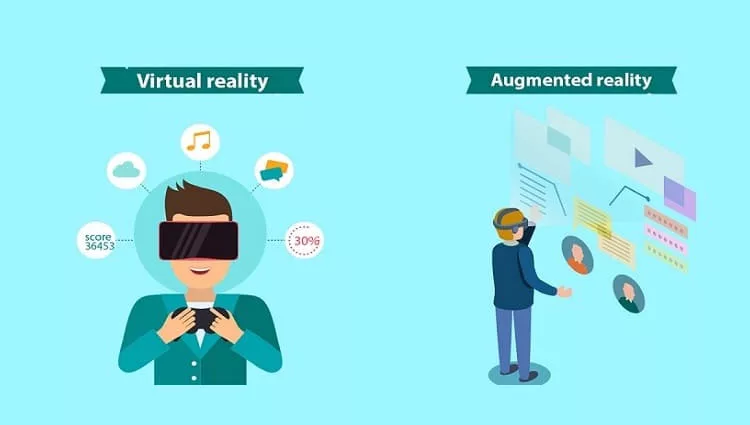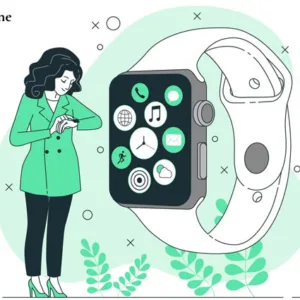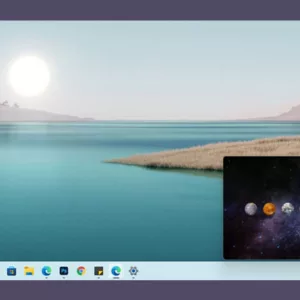In this age of technology and innovation, you shall realize that Virtual Reality (VR) and Augmented Reality (AR) can change our perception of reality. They can take us to breathtaking new worlds or add digital layers to our everyday surroundings, making us question what’s real and what’s not. But here’s the thing – VR and AR are different, and some confuse them as working on the same technology. We will try to understand the main differences between AR and VR to understand why other brands are making moves to integrate these services into their services.
What is Augmented Reality?
Augmented Reality (AR) is a revolutionary new-age technology that seamlessly blends virtual content with the real world, creating an immersive and interactive experience. It involves using specialized hardware components, including input devices, sensors, processors, and output devices, to enable users to directly or indirectly interact with computer-generated content overlaid onto their physical environment. Input devices in AR allow users to provide commands and interact with the virtual content. These can include handheld controllers, gesture recognition devices, or voice commands. Sensors play a crucial role in collecting real-time data about the user’s environment, such as location, orientation, and movement. This data is used to align the virtual content with the real world. Sensors can include accelerometers, gyroscopes, GPS, and depth sensors of your mobile phone and camera devices.
The processor in an AR system is responsible for processing the collected data and executing the necessary software algorithms to seamlessly integrate virtual content with the real world. This requires complex computations, including computer vision techniques for tracking the user’s position and orientation in real time and rendering the virtual content with accurate perspective and lighting. Output devices in AR are used to present the blended reality to the user. These can range from simple displays like smartphones or tablets to more sophisticated devices like head-mounted displays (HMDs) or smart glasses. HMDs, for example, can provide a more immersive experience by overlaying virtual content directly onto the user’s field of vision, creating a sense of depth and presence.
AR is applied in diverse fields, including medicine, architecture, manufacturing, and gaming. Especially after browser-based augmented reality, WebAR has made its way into immersive tech, and it is used extensively by companies across business applications. In medicine, AR is used in surgical planning and training, allowing surgeons to overlay virtual images onto the patient’s anatomy to enhance visualization and accuracy during procedures. AR is used for virtual walkthroughs and simulations in architecture, enabling architects to visualize and modify building designs in real-world contexts. AR is used for assembly and maintenance tasks in manufacturing, providing workers with real-time instructions and guidance overlaid with physical objects.
What is Virtual Reality?
Virtual reality (VR) is a cutting-edge technology that transports users to a new world of immersive experiences. It’s not just about gaming and entertainment anymore – VR is making waves in various industries, from healthcare to engineering and everyday business operations. Imagine putting on a VR headset and instantly finding yourself in a virtual environment where you can move around, interact with objects, and experience sensations as if they were real. Some VR headsets, like the Oculus Rift or HTC Vive, are connected to powerful computers or game consoles, providing high-quality graphics and realistic interactions. Others, like Google Cardboard or Samsung Gear VR, use your smartphone to create the VR experience. There are also standalone headsets like the Oculus Quest that don’t require any additional devices, offering freedom of movement and convenience.
The potential of VR is mind-blowing. In the healthcare industry, surgeons can use VR to practice complex surgeries and plan procedures precisely, reducing risks and improving patient outcomes. In engineering and construction, VR can simulate and visualize architectural designs, allowing stakeholders to walk through virtual buildings before they are built, saving time and resources. Even in education, VR can provide immersive and interactive learning experiences, transporting students to historical events, science experiments, or distant places they may not otherwise have access. Businesses are also leveraging VR to enhance their operations. Retail and E-Commerce brands are emphasizing integrating immersive technology to recreate the showroom experience online where people can view their products, interact and buy. Automotive companies are using VR to simulate driving experiences and test vehicle designs. And marketing teams can create captivating and interactive VR experiences to engage customers, offering a unique and memorable brand experience.
Notable Differences Between Augmented Reality and Virtual Reality
Now, we will see some essential differences that differentiate Augmented reality from Virtual reality.
How you perceive reality is different!
Augmented Reality (AR) and Virtual Reality (VR) are sophisticated technologies revolutionizing how we engage with digital content. AR enhances our physical environment with computer-generated inputs such as audio, video, GPS overlays, and digital content that responds to real-time stimuli. This allows users to seamlessly blend the virtual and physical worlds, creating immersive and interactive experiences. On the other hand, VR transports users to an entirely virtual environment, replacing the real-world setting with a digitally conceptualized space.
One compelling example of AR in action is the fashion brand Gucci, which launched an iOS app powered by AR technology. This app lets customers try on their Ace sneakers collection virtually, providing an interactive and personalized experience that gained popularity during the Covid-19 pandemic when physical stores were closed. Your brand can also leverage the technology and showcase your product in this manner and reach a wide range of audience.
Similarly, luxury brand Prada has embraced VR with their Virtual Reality project. This innovative initiative allows users to take virtual tours of Prada’s renowned stores worldwide, providing a unique and immersive experience. Users can also indulge in virtual fashion shows and get a sneak peek at new collections through Prada’s YouTube VR and VEER channels. The potential of AR and VR goes beyond the fashion industry. These technologies are being increasingly adopted in various sectors, including gaming, education, healthcare, and engineering.
They offer businesses new opportunities to engage with customers, provide innovative solutions, and enhance user experiences. As AR and VR continue to evolve and mature, we can expect even more exciting and practical use cases in the future. From interactive shopping experiences to virtual training simulations, these technologies are reshaping the way we interact with the digital world, offering a glimpse into the limitless possibilities of the immersive and interactive future.
Different Accessing Devices
AR technology is cool because you don’t need any fancy gear like a headset to use it. You can whip out your smartphone or tablet, point the camera at something, and watch the magic happen. You can take the example of those fun filters on Snapchat or Instagram that put cute bunny ears on your face. That’s a great example of how AR works. It uses artificial intelligence to detect your face and then overlays those filters in real time, making it look like they’re on your face.
On the other hand, VR is a whole different ball game. To fully immerse yourself in a virtual reality experience, you need to gear up with some accessories like headphones and a VR headset that covers your eyes. These headsets, like Google Cardboard, Oculus Rift, Google Daydream, or Gear VR, are equipped with head-tracking technology that lets you look around the virtual world by moving your head.
Some VR setups even have hand controllers that let you use real-world gestures to interact with the virtual environment and Metaverse. It’s like having superpowers in a virtual world where you can immerse yourself entirely and interact with the objects around you. So, whether you’re exploring a virtual fantasy land or trying out funny filters on your selfies, AR and VR technologies are changing the game and taking our digital experiences to a different level altogether.
Usage of Internet Bandwidth
Let’s talk about bandwidth. So, to make AR and VR experience you need the internet. You need some severe bandwidth capacity to make it happen when it comes to live streaming operations with top-notch quality.
To understand the difference, even low-resolution 360-degree videos in AR need at least 25 Mbps to deliver a decent experience. But when we take more perspective, those mobile 360-degree videos differ from the mind-blowing dynamic range and resolution that dedicated 360-degree cameras can capture.
As mobile display technology keeps advancing, bandwidth requirements will only increase. I’m talking about hundreds of megabit/s to several gigabit/s per second for a fully immersive AR retinal experience. This is one of the reasons behind the telecom industry and its sincere efforts to create an infrastructure that can maintain high-speed data without fluctuation or drops in speed.
When it comes to VR, things get more advanced. You’re looking at 80-100 Mbps for HD TV-level resolution. But if you want to go all out with a mind-blowing VR retinal 360° video experience that includes a 4K TV, you better buckle up because it can require as much as 600 Mbit/s. Each VR stream has to be duplicated twice to stream separately to both eyes, which means even more bandwidth is needed. According to the experts, a 720p VR video stream alone requires a minimum of 50 Mbps. So, if you want smooth audio and flawless hand gestures in your virtual world, high-speed internet is a necessity you cannot ignore at all.
Conclusion
As AR and VR technologies continue to evolve, they are becoming increasingly specialized and hold immense promise for the future. With growing interest in novel AR and VR systems, consumers are eager to experiment with these technologies’ endless possibilities. AR and VR have unique applications that provide users with innovative, interactive, and memorable experiences from gaming to education, training to entertainment. Brands that invest in these technologies stand to benefit in several ways. If you are considering integrating AR or VR into your business, no-code platforms like www.plugxr.com could be the best place to begin with.
You will be able to create AR and VR content to provide immersive brand experiences that captivate and engage consumers on a whole new level. Brands can create interactive AR experiences that blend the digital and physical worlds, allowing users to visualize products in their environment, try out virtual samples, or even virtually try on clothes or accessories. This creates a personalized and memorable brand interaction that leaves a lasting impression.





